2023 Best Places For Boondocking In A Skoolie
The Best Places for Boondocking In A Skoolie
One of the most common questions we get from our readers and followers are “Where are the best places for boondocking in a skoolie?” We will get to that very question and reveal all of our secrets, tips, tricks, and knowledge just for you!
Living and traveling in a skoolie can be an exciting and fulfilling lifestyle choice for those who love adventure and have a sense of independence. A skoolie is a converted school bus that has been transformed into a living space, usually with all the basic amenities of a regular home.
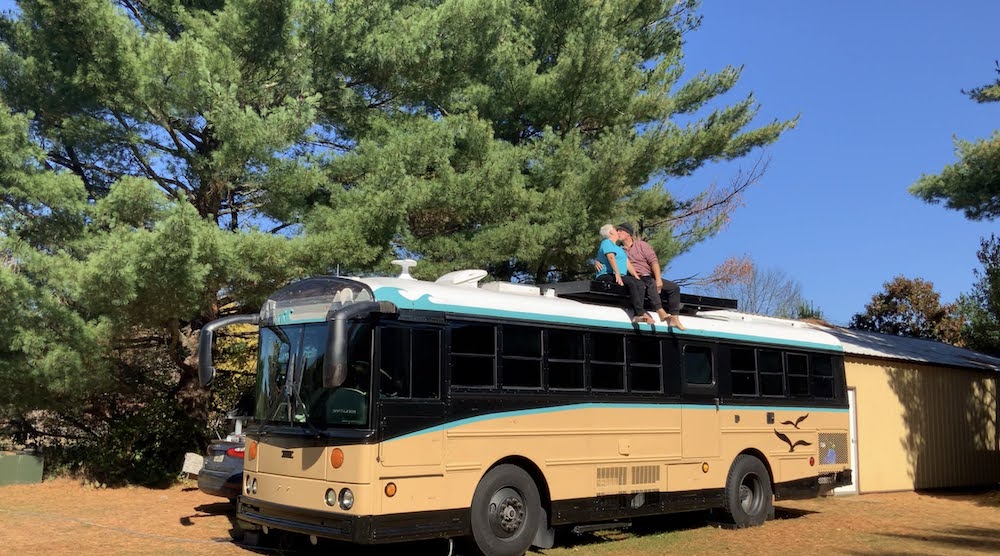
Here are some things to keep in mind if you're considering living, traveling and boondocking in a skoolie:
- Building and designing your skoolie:
Building and designing your skoolie can be a fun and creative process, but it's important to have a solid plan in place before you begin. Make sure you research and understand the legal requirements for converting a school bus into a living space, including any necessary permits and certifications.
If you plan on boondocking in a skoolie, you need to build the bus to accommodate a boondocking lifestyle. - Maintenance:
Like any vehicle, a skoolie requires regular maintenance to ensure it remains safe and functional. This includes things like oil changes, tire rotations, and regular inspections. - Storage and space management:
Space is limited in a skoolie, so it's important to be mindful of how you use and manage your space. You may need to get creative with storage solutions and make the most of every inch of available space. - Budgeting:
Living and traveling in a skoolie can be a cost-effective lifestyle choice, but it's important to budget carefully and be aware of any unexpected expenses that may arise. - Parking and camping:
When traveling in a skoolie, you'll need to plan ahead for parking and camping. There are many resources available online for finding free or low-cost places to park overnight, but it's important to be respectful of local laws and regulations.
Parking, camping, and boondocking in a skoolie can be one of the biggest hurdles for those seeking this lifestyle. We are going to look at all, or at least, a majority of the ways to legally and safely boondock while living and traveling in a skoolie
Overall, living, traveling, and boondocking in a skoolie can be an incredible experience for those who are willing to put in the time and effort to make it work. It's a lifestyle that offers a sense of freedom and independence that's hard to find in traditional living situations.
What Does It Mean To Go Boondocking In A Skoolie?
Boondocking in a skoolie (a converted school bus used as a recreational vehicle) refers to camping or parking in a remote location without access to amenities such as water, electricity, or sewer hookups.
It often involves parking on public lands such as Bureau of Land Management (BLM) areas, national forests, or other areas where camping is allowed. Boondocking can also refer to staying overnight in a parking lot or other urban area without access to amenities, although this is less common in the skoolie community.
Boondocking requires self-sufficiency, including the ability to generate electricity, carry and store water, and manage waste. Many skoolie owners enjoy boondocking as a way to experience nature, save money on campground fees, and live more simply and independently.
Advantages and Challenges of Boondocking in a Skoolie
Boondocking in a skoolie can be a great way to explore the outdoors and live more sustainably. Doing so in a skoolie, or converted school bus, offers some unique advantages and challenges.
Advantages of Boondocking In A Skoolie:
- Freedom and Flexibility:
Boondocking in a skoolie allows you to travel where you want, when you want, without worrying about campground reservations or hookups. - Cost savings:
Boondocking in a skoolie can be a cost-effective alternative to paying for campsites or RV parks. - Sustainability:
When boondocking in a skoolie, it allows you to live off-grid and reduce your environmental impact by using renewable resources like solar power. - Unique Experience:
Boondocking in a skoolie provides you with an experience of nature and the outdoors in a unique and intimate way, without the distractions of modern life.
Challenges to Boondocking In A Skoolie
- Finding suitable campsites:
Boondocking in a skoolie requires finding suitable campsites that are legal to camp in, have enough space for a bus, and are accessible. This can be challenging in some areas, especially if you're looking for remote or secluded spots. - Water and waste management:
Without hookups, you'll need to be self-sufficient in terms of water and waste management. This can be challenging, especially if you're not used to living off-grid or if you're traveling with a group. Boondocking in a skoolie is quite different than camping in an RV campground. There is no endless supply of freshwater at the end of a garden hose. - Energy management:
Boondocking in a skoolie requires managing your energy usage carefully, especially if you're relying on solar power. You'll need to be mindful of your electricity usage and make sure you have enough power to meet your needs. - Weather conditions:
Living and boondocking in a skoolie means being exposed to the elements, including extreme temperatures, rain, wind, and snow. You'll need to be prepared for these conditions and make sure your bus is equipped to handle them.
Boondocking in a skoolie can be a rewarding and unique experience, but it also comes with some challenges. Careful planning and preparation can help you overcome these challenges and make the most of your time on the road.
Boondocking In A Skoolie Basics
Boondocking in a skoolie can be an exciting and rewarding experience, but it's important to keep in mind some basic principles to ensure a safe and enjoyable trip. Here are some boondocking basics when boondocking in a skoolie:
- Plan your route:
Before setting out, make sure to plan your route carefully, considering your destination, weather conditions, and available amenities along the way. Use reliable maps, GPS systems, and travel guides to ensure you stay on track. - Know your skoolie's capacity:
Understanding your skoolie's capacity is essential when boondocking. This includes fuel capacity, fresh water, grey water and black water holding tanks, and battery life. Knowing these limits will help you plan your trip and avoid running out of necessary resources. - Find a safe spot:
When you arrive at your boondocking destination, find a safe spot to park your skoolie. Look for level ground, a clear area with no obstacles, and avoid parking too close to cliffs or bodies of water. If possible, park in a designated boondocking area. - Practice Leave No Trace principles:
When boondocking in a skoolie, it's essential to practice Leave No Trace principles. This means taking out all of your trash, disposing of wastewater appropriately, and respecting the environment around you. Leave the area as you found it, or better. - Stay connected:
Even when boondocking, staying connected to your family, friends, and the outside world is essential for safety and communication. Make sure to have a reliable means of communication such as a cell phone or two-way radio. Consider investing in a portable solar panel or generator to recharge your devices and power your skoolie. - Be respectful of others:
If you're boondocking near other people, be respectful of their space and privacy. Keep noise levels down, don't park too close to others, and avoid littering or leaving a mess. - Be prepared:
Finally, always be prepared for unexpected situations. Bring extra food, water, and supplies, and consider investing in a first-aid kit and emergency equipment like flares or a whistle. Be aware of local wildlife and have a plan for dealing with them if necessary.
By following these boondocking basics, you can have a safe and enjoyable experience when boondocking in a skoolie.
Understanding legal and ethical boondocking practices
Boondocking in a skoolie, also known as free camping or dispersed camping, refers to camping in remote and undeveloped areas without any amenities such as water, electricity, or designated campsites. While boondocking in a skoolie can be a fun and rewarding experience, it is important to understand the legal and ethical considerations involved in this practice.
Legal Considerations for Boondocking In A Skoolie
- Check the rules:
Before heading out, research the local regulations and restrictions related to boondocking. Some areas may prohibit it or have specific rules about where and for how long you can camp. - Respect private property:
Boondocking on private land without the owner's permission is trespassing and illegal. - Be mindful of wildlife:
Campers should be aware of protected wildlife areas, nesting grounds, and migration routes. Disturbing wildlife is not only unethical but also illegal. Besides the ethical perspectives, wildlife can be dangerous to you, your family, and your pets.
Ethical Considerations for Boondocking In A Skoolie
- Leave no trace:
When boondocking in a skoolie, it is essential to leave the area as you found it. This means packing out all trash, burying human waste, and not leaving any evidence of your presence.
There are certain principles and mantras we live by and will preach to others until everyone adheres to them. Leaving no trace, especially when you boondock in a skoolie is one of them.
Everyone of you is an ambassador to other skoolie, van lifers, and RV'ers everywhere. One inconsiderate bonehead can ruin it for the rest us. - Respect others:
Boondocking in a skoolie in a remote area means you may encounter other campers, hikers, or hunters. It is important to respect their space and keep noise levels to a minimum. - Practice fire safety:
Campfires should be built in designated areas and never left unattended. Make sure to extinguish the fire completely before leaving the site.
By understanding and adhering to the legal and ethical considerations of boondocking in a skoolie, campers can enjoy this unique outdoor experience while minimizing their impact on the environment and other people.
Choosing a Suitable Location – Boondocking in a Skoolie
It's important to choose a suitable location for boondocking in a skoolie to ensure a safe and enjoyable experience.
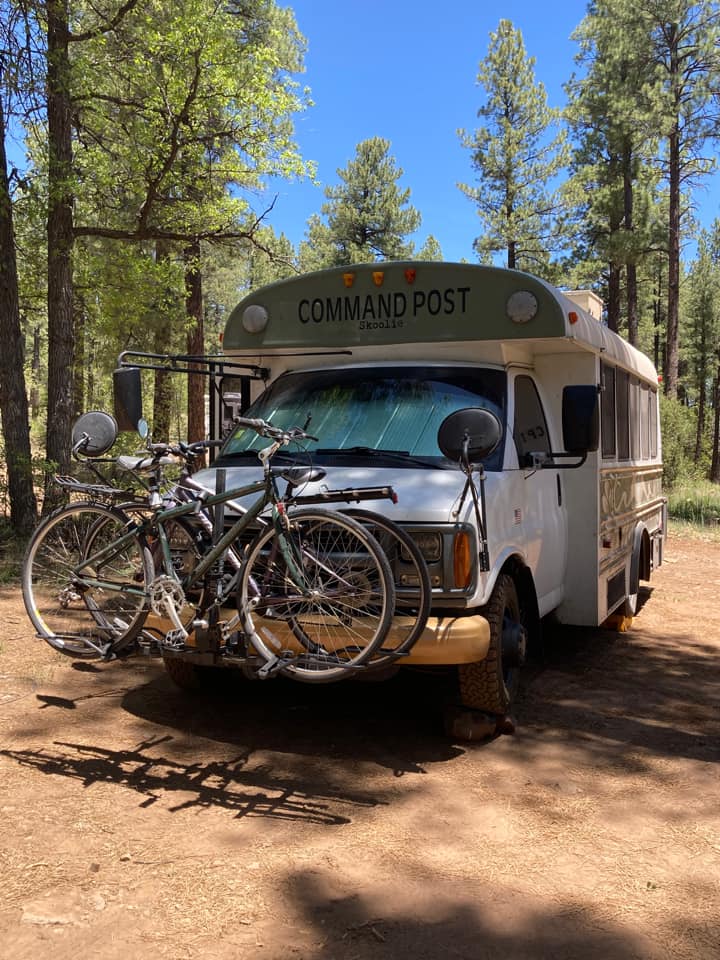
Here are some tips to help you choose a suitable location:
- Research and plan ahead:
We can not emphasize enough the importance of planning ahead. We talk about it all of the time and will mention it several times.
Before heading out to a boondocking location, do some research and plan ahead. Look for places that allow boondocking in a skoolie and check the rules and regulations for the area. - Check for local weather conditions:
Make sure to check the local weather conditions for the area you plan to boondock in. Avoid areas prone to flash floods, wildfires, or extreme weather conditions. - Look for level ground:
Choose a level ground to park your vehicle. Avoid parking on slopes or uneven terrain as this can be dangerous. Even when using your wheel chocks, parking and camping on level ground is just the logical and intelligent thing to do when possible. - Check for access:
Make sure you can easily access the location with your vehicle. Avoid narrow or steep roads that can be difficult to navigate. - Look for privacy:
Choose a location that offers privacy and solitude. Avoid busy areas or places with high foot traffic. - Check for cell phone signal:
Ensure there is good cell phone signal in case of an emergency. If there is no cell phone coverage and you have Starlink, set it up and have it available so you can at least make a WIFI phone call in an emergency situation. - Leave no trace:
When choosing a location, make sure to respect the environment and leave no trace. Avoid damaging the natural surroundings or leaving behind any trash. - Be aware of your surroundings:
Keep an eye out for any wildlife, insects, or poisonous plants in the area. Avoid areas with high risk of wildlife encounters such as bear country or snake-infested areas.
This is something you will hear us mention over and over again. Situational awareness is one of the best skills you can ever hope to hone while living and traveling as a nomad.
By following these tips, you can choose a suitable location for boondocking that is safe, enjoyable, and respectful of the environment.
Safety Precautions
When boondocking, it is important to take certain safety precautions to ensure a safe and enjoyable experience. Here are some safety tips to keep in mind while boondocking in a skoolie:
- Plan ahead:
Before setting out to a remote location, research the area thoroughly and plan your trip accordingly. Check the weather forecast, map out your route, and ensure that your vehicle or RV is in good working order. - Bring adequate supplies:
Since you won't have access to amenities like running water and electricity, make sure to bring enough supplies to last your entire trip. This includes food, water, fuel, and batteries. - Be aware of your surroundings:
When boondocking in a skoolie, you'll be in a remote area with few or no other people around. Be aware of your surroundings and keep an eye out for any potential dangers or hazards, such as wildlife, rough terrain, or extreme weather conditions. - Practice good campsite etiquette:
When setting up camp, be respectful of the natural environment and follow Leave No Trace principles. Don't litter, dispose of waste properly, and avoid disturbing local wildlife. - Stay connected:
Since you'll be in a remote area without cell phone reception, make sure to have a reliable means of communication, such as Starling, a satellite phone, or a two-way radio. - Carry safety equipment:
Bring along safety equipment such as a first aid kit, fire extinguisher, and emergency flares. - Inform someone of your location:
Let someone know where you're going and when you expect to return. This will ensure that someone is aware of your location in case of an emergency. - Self Defense and Protection
There is always the potential for a dangerous situation when boondocking in a skoolie.
Having a firearm, bear spray, mace, a bat, or knife could mean the difference between a victorious situation or a malleable defeat. We wrote a piece on How To Avoid Dangerous Animals While Camping.
Use what ever means to protect you and your pack is necessary and what you are comfortable with.
By following these safety precautions, you can have a safe and enjoyable boondocking experience.
Places To Go Boondocking in a Skoolie
Yes, there are many places where you can go boondocking in a skoolie. Boondocking refers to camping in a location without access to hookups for electricity, water, and sewer. Skoolies, or converted school buses, are often designed to be self-contained and can function off-grid for extended periods.
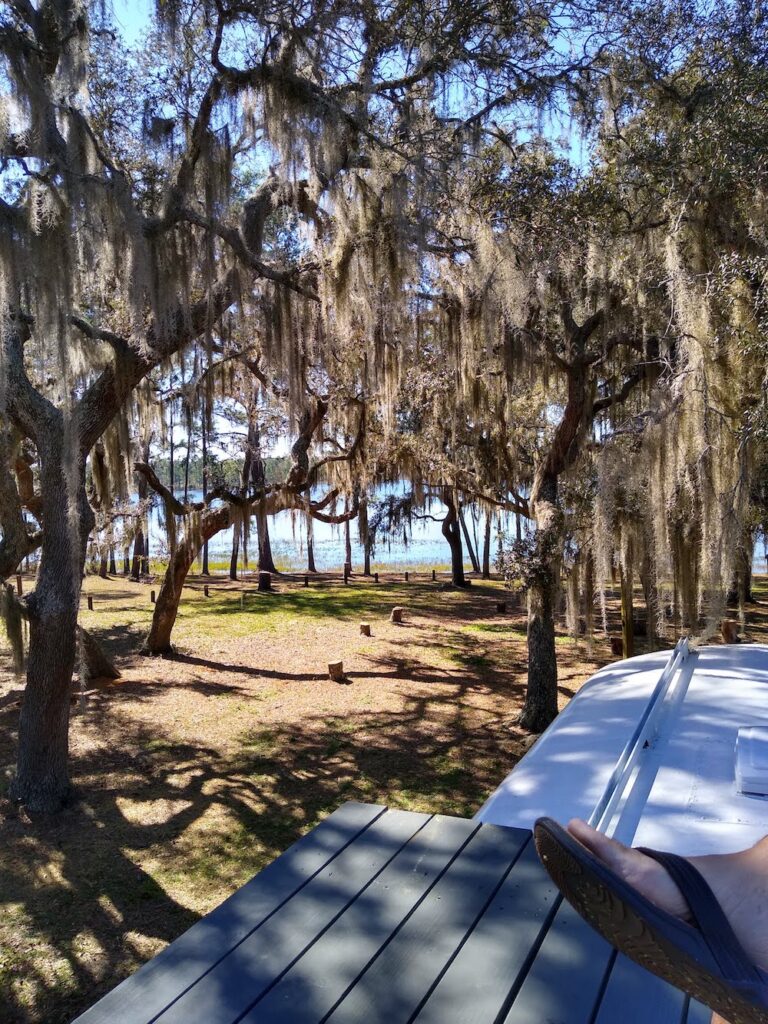
Some popular places to go boondocking in a skoolie include national forests, Bureau of Land Management (BLM) lands, and other public lands where dispersed camping is allowed. Many RV parks and campgrounds also offer boondocking options, such as parking in their overflow or dry camping areas.
It's important to note that boondocking regulations vary by location and it's important to check with the local authorities before setting up camp. Some areas may have restrictions on how long you can stay, where you can park, and what kind of amenities you can use. Additionally, be sure to practice Leave No Trace principles and minimize your impact on the environment while boondocking.
Public Lands
Boondocking in a skoolie on public lands can be a great way to explore the great outdoors and experience the freedom of the open road. However, there are some important things to keep in mind to ensure that you do so safely and responsibly.
1. It's important to research the specific regulations and guidelines for boondocking in a skoolie on public lands in the area you plan to visit. This information can usually be found on the website of the agency that manages the land, such as the Bureau of Land Management or the U.S. Forest Service.
2. It's important to practice Leave No Trace principles while boondocking in a skoolie. This means packing out all of your trash and waste, staying on designated roads and trails, and respecting the natural environment by not disturbing wildlife or damaging vegetation.
Imaging finally reaching your camping destination after day and weeks of planning and traveling only to find the person camping there before left trash, toilet paper, plastic bottles, and all kinds of other nastiness.
3. It's important to have the necessary supplies and equipment to boondock safely and comfortably. This may include a reliable source of drinking water, a generator or solar panels for power, and a portable toilet or other waste disposal system.
Finally, it's important to be respectful of other campers and visitors to the public lands. Keep noise levels down, don't block access to trails or other areas, and be mindful of the impact that your presence may have on others who are also enjoying the outdoors.
By following these guidelines, you can enjoy a safe and enjoyable boondocking experience in your skoolie on public lands.
Bureau of Land Management (BLM) – Places For Boondocking in a Skoolie
Boondocking on Bureau of Land Management (BLM) areas is a popular activity among outdoor enthusiasts who want to camp for free and experience the beauty of nature. Boondocking, also known as dispersed camping, is a form of camping that does not involve staying at designated campsites or established campgrounds.
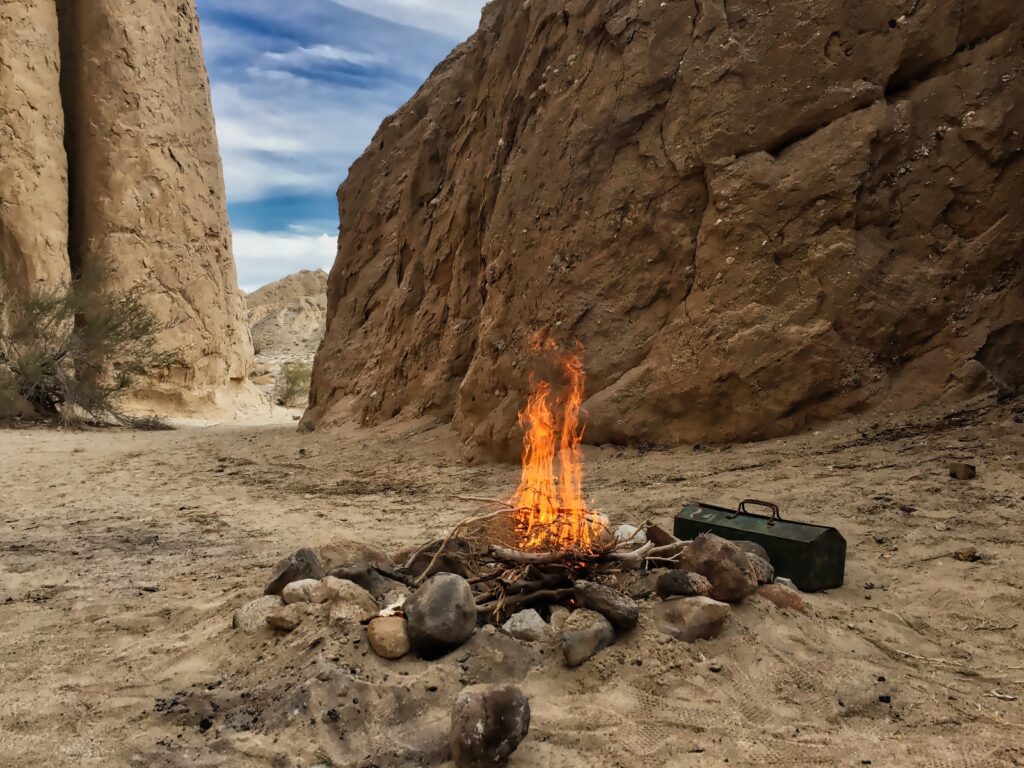
BLM manages millions of acres of public land across the United States, including areas where boondocking is allowed. However, there are some important things to keep in mind before you decide to boondock on BLM land:
- Check BLM regulations:
BLM has specific regulations regarding boondocking, so make sure to check with the local BLM office before setting up camp. Some areas may have restrictions on the length of stay, number of people or vehicles, and the use of campfires. - Be prepared:
Since there are no facilities like restrooms or water supply on BLM lands, it's important to bring everything you need, including food, water, and a portable toilet. Also, make sure to leave no trace and pack out all your trash. - Respect nature and wildlife:
Boondocking on BLM land is a great way to experience nature, but it's important to respect the environment and wildlife. Avoid disturbing natural habitats and keep a safe distance from any animals you may encounter. - Be self-sufficient:
In case of an emergency, you should be able to take care of yourself. Bring a first aid kit, a map, and other essential items like a flashlight, extra batteries, and a radio. - Stay safe:
BLM lands can be remote and isolated, so it's important to take safety precautions. Let someone know where you'll be and when you plan to return, and be aware of weather conditions and other potential hazards.
Overall, boondocking in a skoolie on BLM lands can be a rewarding experience, but it's important to follow regulations, be prepared, and respect the environment and wildlife.
Where Can I Find BLM Locations Throughout North America?
The Bureau of Land Management (BLM) is an agency within the United States Department of the Interior that manages over 245 million acres of public land, primarily located in western states. While the BLM does not have locations throughout all of North America, they do have offices and field offices in the following locations where boondocking in a skoolie is just at your fingertips:
United States:
- Alaska
- Arizona
- California
- Colorado
- Idaho
- Montana
- Nevada
- New Mexico
- North Dakota
- Oregon
- South Dakota
- Utah
- Wyoming
Canada:
The BLM does not have any locations in Canada.
Mexico:
The BLM does not have any locations in Mexico.
It is worth noting that the BLM manages primarily federal lands within the United States, and does not have jurisdiction over public lands in Canada or Mexico.
National Forests – Boondocking in a Skoolie
Boondocking in a skoolie in National Forests, also known as dispersed camping, is a popular activity among outdoor enthusiasts who enjoy camping in remote locations and want to get away from crowded campsites. Boondocking involves camping in undeveloped areas of National Forests, away from established campgrounds, without any amenities or services.
Boondocking is generally allowed in National Forests, but regulations and guidelines may vary by region or forest, so it's important to check with the local forest service office before heading out. Some National Forests may have specific areas designated for dispersed camping, while others may have restrictions on where and how long you can camp.
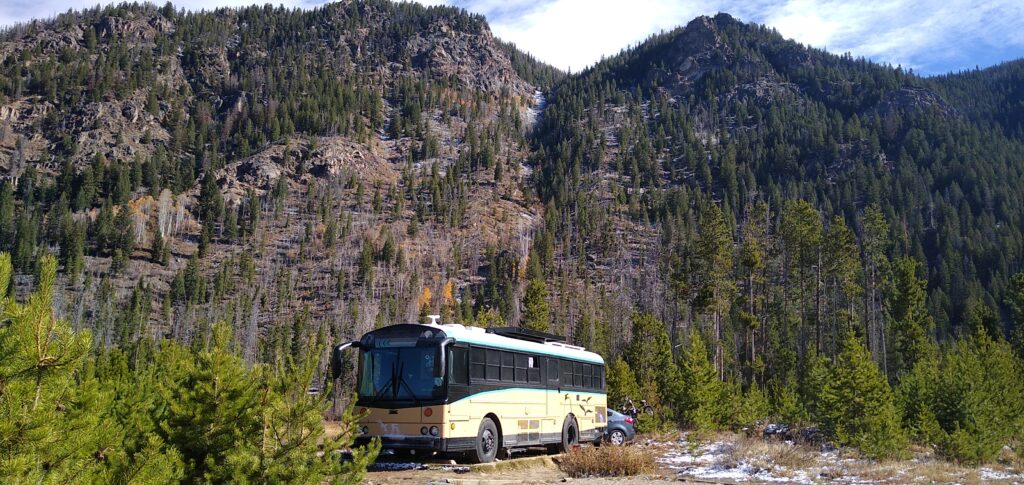
When boondocking in a skoolie in National Forests, it's important to practice Leave No Trace principles, which means packing out all trash, burying human waste at least 200 feet from water sources, and avoiding damage to the natural environment. Campfires may be allowed in some areas, but always check for fire restrictions before starting a fire and make sure to fully extinguish it before leaving.
It's also important to be prepared when boondocking in National Forests, as there are no amenities or services available. Make sure to bring enough water, food, and supplies for your trip, and be aware of any potential hazards such as wildlife or extreme weather conditions.
Overall, boondocking in National Forests can be a rewarding and unforgettable experience for those who enjoy camping and exploring the great outdoors. Just make sure to follow all regulations and guidelines to protect the environment and ensure a safe and enjoyable trip.
National Grasslands – Boondocking in a Skoolie
Boondocking in a skoolie on national grasslands refers to camping in remote areas without any designated campgrounds or facilities. National grasslands are managed by the United States Forest Service, and they offer a great opportunity for boondocking enthusiasts who want to enjoy nature in a more secluded setting.
Here are some tips for boondocking in a skoolie on national grasslands:
- Check for camping restrictions:
Some areas may have restrictions on where you can camp, so it's essential to check the rules and regulations before setting up camp. - Bring plenty of supplies:
Since there are no facilities in most boondocking areas, it's important to bring all the supplies you need, including food, water, and toiletries. - Respect the environment:
When boondocking on national grasslands, it's important to follow the principles of Leave No Trace. This means packing out all trash and minimizing your impact on the environment. - Be prepared for the weather:
National grasslands can experience extreme weather conditions, so make sure to bring appropriate clothing and gear for the season. - Practice fire safety:
Campfires are a common part of boondocking, but it's important to follow fire safety guidelines to prevent wildfires. Make sure to only start fires in designated areas and fully extinguish them before leaving.
By following these tips, you can have a safe and enjoyable boondocking experience on national grasslands.
National Wildlife Refuges – Boondocking in a Skoolie
Boondocking in a skoolie in National Wildlife Refuges refers to the act of camping in a self-contained vehicle, such as an RV or camper, in a designated area within a wildlife refuge without hookups to any utilities or amenities. While not all National Wildlife Refuges allow boondocking, many do provide opportunities for visitors to camp in a natural setting and enjoy the refuge's wildlife and outdoor recreation activities.
Before embarking on a boondocking trip to a National Wildlife Refuge, it's important to check the refuge's specific regulations and guidelines. Some refuges may require permits or have restrictions on where and how long visitors can camp. Additionally, visitors should practice Leave No Trace principles to minimize their impact on the environment and wildlife.
Boondocking in a skoolie in National Wildlife Refuges can be a rewarding and unique way to experience the great outdoors and connect with nature. However, visitors should also be prepared for potential challenges, such as limited access to amenities, inclement weather, and encounters with wildlife. It's important to come prepared with adequate supplies and equipment and to follow all safety guidelines provided by the refuge.
Army Corps of Engineers Lands – Boondocking in a Skoolie
The Army Corps of Engineers (USACE) manages millions of acres of public lands, including lakes, rivers, and recreational areas across the United States. Some of these lands allow for dispersed camping, also known as boondocking, while others do not.
The rules and regulations regarding dispersed camping on USACE lands vary depending on the specific location. Before camping on USACE lands, you should check with the local USACE office to determine if dispersed camping is allowed and any specific rules and regulations that apply.
In general, USACE lands that allow dispersed camping may have designated camping areas, and may require a permit or fee. Additionally, campers may be required to follow certain rules and regulations, such as using only established campsites, limiting campfires to designated areas, and properly disposing of trash and waste.
It's important to remember that while boondocking in a skoolie on public lands can be a rewarding and enjoyable experience, it's also important to practice Leave No Trace principles and respect the land, wildlife, and other visitors.
State Forests – Boondocking in a Skoolie
The rules and regulations for boondocking (also known as dispersed camping) in state forests vary by state and even by forest. In some state forests, boondocking is allowed in designated areas or with a permit, while in others it may be prohibited altogether.
It's important to research the specific state forest where you plan to boondock and check for any rules or regulations that may apply. You can typically find this information on the forest's website or by contacting the forest ranger's office.
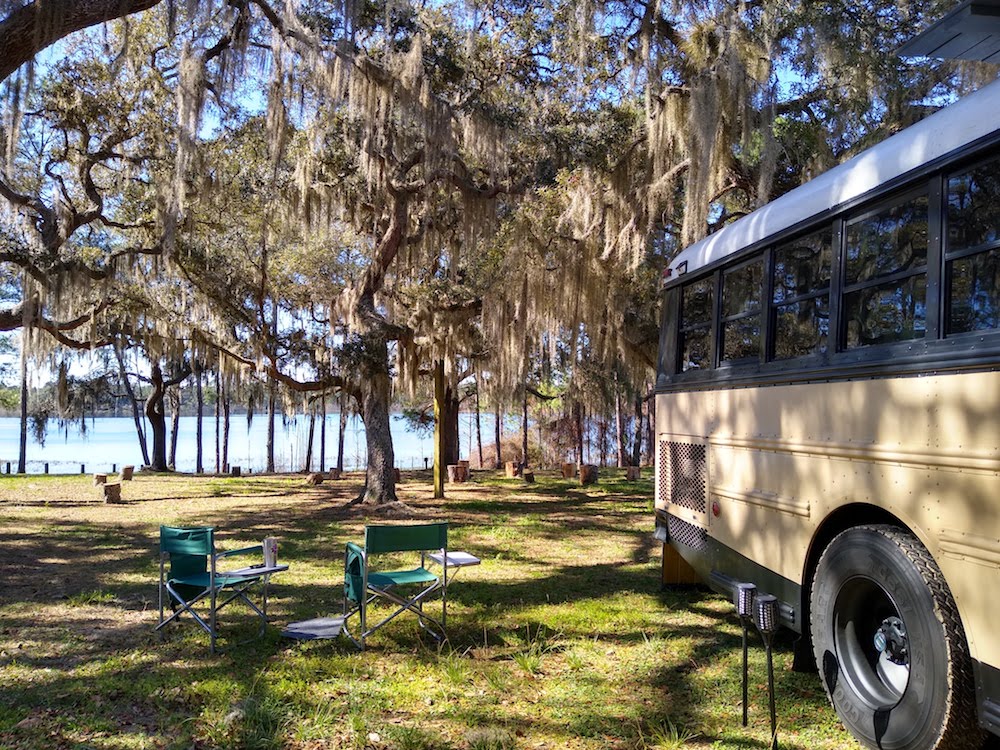
In general, when boondocking in a skoolie in state forests, it's important to follow Leave No Trace principles and respect the environment. This includes packing out all trash and minimizing your impact on the land. Additionally, be aware of any potential hazards such as wildlife, rough terrain, or weather conditions.
State Wildlife Management Areas – Boondocking in a Skoolie
Wildlife Management Areas (WMAs) are often managed by state wildlife agencies to provide habitat for wildlife, as well as recreational opportunities for the public. Some WMAs may allow for boondocking.
Whether or not boondocking is allowed in a particular WMA will depend on the specific rules and regulations of that area. Some WMAs may have designated camping areas or primitive campsites where boondocking is allowed, while others may prohibit camping altogether.
It's important to check the regulations and guidelines for the specific WMA you plan to visit before attempting to boondock.
Florida Water Management Areas – Boondocking in a Skoolie
Boondocking in a skoolie in Florida Water Management areas is generally allowed, but there are certain rules and regulations that must be followed. Florida Water Management areas are public lands managed by the South Florida Water Management District, and they provide opportunities for outdoor recreation, including camping and hiking.
Before boondocking in a Florida Water Management area, it's important to check the district's website for any rules or regulations specific to the area you plan to visit. Some areas may have restrictions on camping, while others may require permits or have designated camping areas.
When boondocking in a skoolie in a Florida Water Management area, it's important to follow Leave No Trace principles and pack out all trash and waste. Additionally, fires may be prohibited or restricted, so be sure to check the regulations before starting a fire.
Overall, boondocking in Florida Water Management areas can be a great way to enjoy the outdoors and explore the natural beauty of Florida, but it's important to do so responsibly and in accordance with the rules and regulations set forth by the South Florida Water Management District.
Private Land – Boondocking in a Skoolie
Boondocking in a skoolie on private land is generally not allowed without the permission of the landowner. Private landowners have the right to control access to their property, and camping on their land without permission is considered trespassing.
If you are interested in boondocking on private land, you should always seek the permission of the landowner first. You can do this by contacting the landowner directly or by working with a website or service that connects landowners with people looking for boondocking opportunities.
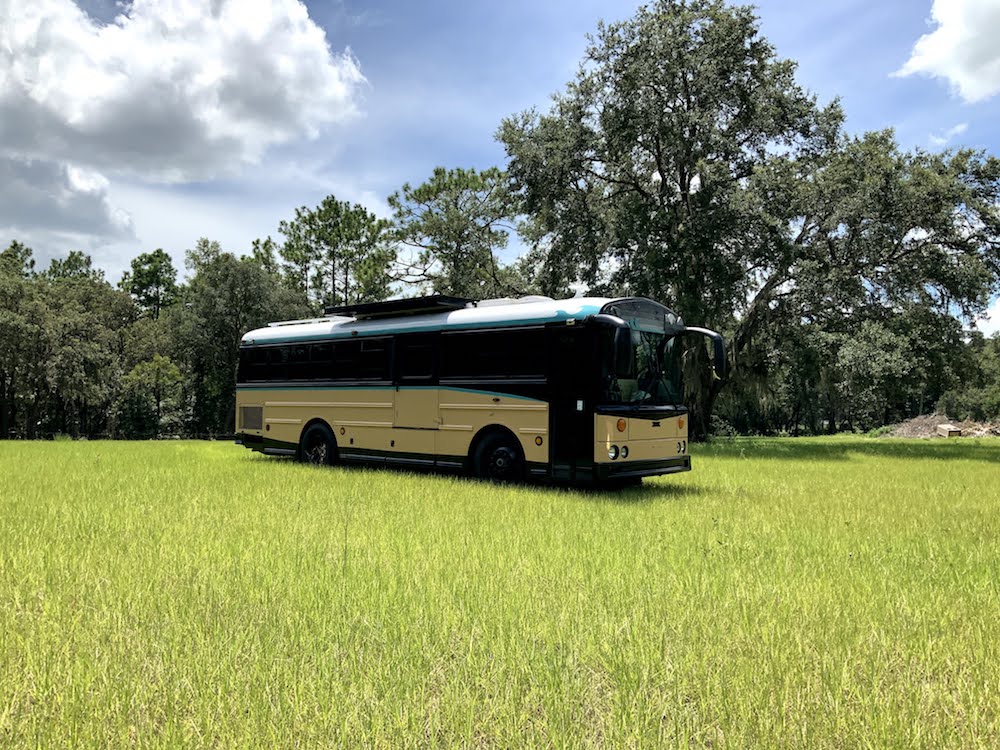
When seeking permission to boondock on private land, it's important to be respectful and considerate of the landowner's property and wishes. Make sure you have a clear understanding of the landowner's expectations and any rules or regulations you need to follow while on their property. Always leave the land as you found it, and take care not to damage the environment or wildlife in the area.
Friends and Family – Boondocking in a Skoolie
Boondocking at a friend or family member's residence typically refers to camping or parking a vehicle, such as an RV or a camper, on their property for a short period of time. Here are some things to consider if you're planning to boondock at someone's home:
- Ask for permission:
Before parking your vehicle on someone's property, make sure you have their permission to do so. It's important to respect their property and not assume that it's okay to park there. - Discuss expectations:
Have a conversation with your friend or family member about what they're comfortable with in terms of your stay. Will you have access to their home or will you be expected to stay in your vehicle? Will you be using their facilities (bathroom, shower, etc.) or will you be self-sufficient? - Be mindful of your impact:
Remember that you're a guest on someone's property and should be respectful of their space. Be mindful of noise levels, waste disposal, and any other factors that could impact their property or their neighbors. - Offer to contribute:
Consider offering to contribute to their household expenses or helping out with chores or other tasks while you're there. This can show your appreciation for their hospitality and help ensure a positive experience for everyone involved.
We have done this on several occasions. In Maine, Virginia, North Carolina, and even down in Florida at my sister’s house. We always find a way to contribute or compensate for our friend’s and family’s kindness and hospitality.
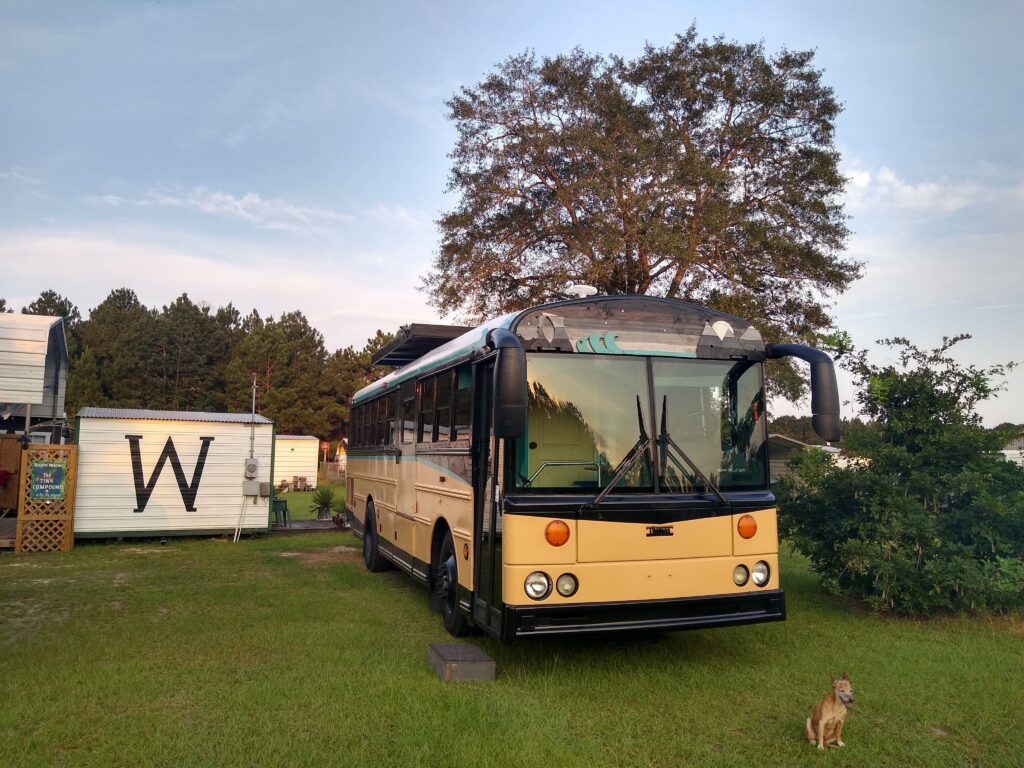
Overall, boondocking at a friend or family member's residence can be a great way to save money on lodging while also spending time with loved ones. Just be sure to communicate clearly, respect their property and expectations, and offer to contribute in some way.
Private Campgrounds – Boondocking in a Skoolie
Boondocking, also known as dry camping, refers to camping without access to hookups for electricity, water, or sewage.
While many private campgrounds offer these amenities, it is still possible to boondock at private campgrounds by following these steps:
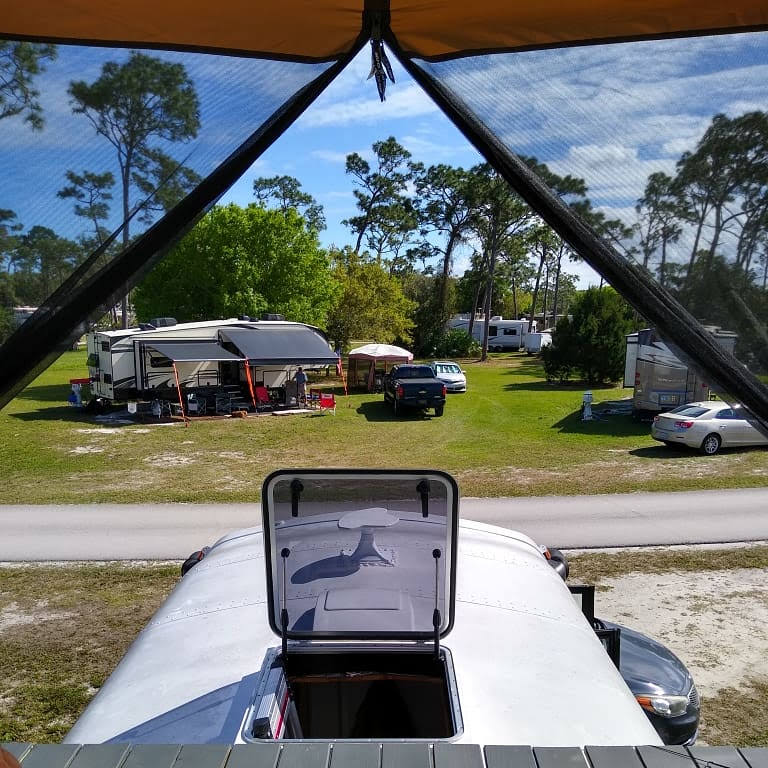
- Research the campground:
Look for private campgrounds that allow boondocking or dry camping. Some private campgrounds may have designated areas for dry camping, while others may allow it in any of their sites. You can find this information on the campground's website or by calling the campground directly. - Check the rules:
Make sure to read the campground's rules and regulations regarding boondocking. Some campgrounds may have restrictions on generator use, quiet hours, or the length of your stay. - Prepare your RV or camper:
Make sure your RV or camper is equipped for boondocking. This may include having a generator, solar panels, or extra water tanks. You may also want to bring a portable waste tank to dump your grey and black water. - Find a suitable spot:
When you arrive at the campground, look for a spot that is suitable for boondocking. This may be a site without hookups or a designated dry camping area. Look for a spot that is level and has enough space for your RV or camper. - Be mindful of resources:
When boondocking, you need to be mindful of your resources. Monitor your water usage, generator use, and waste tank levels. You may also want to bring extra batteries or a solar charger for your electronic devices. - Follow the rules:
Make sure to follow the campground's rules and regulations. This includes being quiet during quiet hours, disposing of your waste properly, and respecting the privacy of other campers. - Be self-sufficient:
Boondocking means being self-sufficient, so make sure to bring everything you need, including food, water, and supplies. Plan ahead and make sure you have enough of everything for the duration of your stay.
By following these steps, you can boondock at private campgrounds and enjoy the freedom and flexibility of camping without hookups.
Harvest Hosts
Harvest Hosts is a membership program that allows RVers to stay overnight at various host locations, such as wineries, farms, and museums, in exchange for supporting the host's business. Boondocking, on the other hand, refers to camping in an RV without hookups or amenities, typically on public land or in remote areas.
While Harvest Hosts does offer unique and often scenic places to stay overnight in an RV, it is not necessarily a boondocking experience. Most of the host locations will provide some level of amenities, such as parking spaces, access to bathrooms, and even electrical or water hookups, depending on the host's policies.
That being said, some Harvest Hosts locations may offer more of a boondocking experience, particularly those that are located on farms or in rural areas. It's always a good idea to research the specific host location beforehand to determine what amenities will be available and whether it fits your idea of boondocking or not.
If you have a membership to Harvest Hosts, be sure to patronize that business before you pack up and move on to your next boondock spot. We have been members of Harvest Host and have always enjoyed the overnight experience and benefits!
Urban Areas – Boondocking In A Skoolie
Boondocking, also known as urban camping or dispersed camping, refers to camping in a location without any amenities or facilities. While it is possible to boondock in urban areas, it may be more challenging than in rural areas due to a lack of available space and stricter laws and regulations.
In many urban areas, camping on public property, such as streets or sidewalks, is prohibited. Private property owners may also restrict camping on their land. Additionally, many urban areas have a higher population density, which means there may be less available space to park and camp.
However, some urban areas may have designated areas where boondocking is permitted. It's important to research local laws and regulations and obtain any necessary permits before attempting to boondock in an urban area. Additionally, it's important to practice responsible camping and leave no trace, ensuring that the area is clean and undamaged when leaving.
Overall, while it may be more challenging to boondock in urban areas, it is possible with proper research and planning.
Walmart Parking Lot – Boondocking In A Skoolie
While it is generally legal to park overnight in a Walmart parking lot, whether or not it is safe to boondock (camp) there depends on various factors.
Firstly, it is important to check if the specific Walmart location allows overnight parking, as some do not due to local ordinances or store policies. You can check with the store manager or look for signs in the parking lot that indicate overnight parking rules.
Assuming overnight parking is allowed, safety concerns can arise due to the location of the Walmart, the time of day or night, and the presence of other individuals in the parking lot. Some Walmart parking lots are located in higher-crime areas or near busy highways, which could increase the risk of theft or other safety issues. Additionally, parking lots can attract homeless individuals or other groups that may pose a threat to boondockers.
It is important to take precautions to ensure your safety if you decide to boondock in a Walmart parking lot. This could include parking in a well-lit area near the store entrance, avoiding areas where people are loitering, and keeping your vehicle locked at all times. You should also have emergency supplies and a plan in case of any safety issues.
Overall, while some people do choose to boondock in Walmart parking lots, it is important to consider the specific location and take necessary precautions to ensure your safety.
Rest Areas and Truck Stops – Boondocking In A Skoolie
Boondocking at truck stops and rest areas can be a convenient and cost-effective way to travel, especially for RVers or those traveling by car who need to take breaks during long road trips. However, it's important to keep in mind that there are some potential challenges and safety concerns that come with boondocking in these areas.
First, it's important to check whether the truck stop or rest area allows overnight parking. Some rest areas may have signs posted that prohibit overnight parking, while others may have designated areas for RVs or other vehicles. Be sure to check local regulations as well, as some states and municipalities may have specific laws regarding overnight parking in public areas.
Second, while many truck stops and rest areas are well-lit and monitored by security cameras, it's still important to take precautions to ensure your safety. Park in well-lit areas, lock your doors, and avoid leaving valuables visible in your vehicle.
Third, be considerate of other travelers and truck drivers who may be parked nearby. Keep noise levels down, avoid using generators or other loud equipment during quiet hours, and be respectful of others' space.
We have spent the night at highway rest areas, Pilot, Loves, and TA truck stops. We’ve even spent the night at a Buc=ees although they have signs prohibiting overnight parking.
Overall, boondocking at truck stops and rest areas can be a convenient and cost-effective option for travelers, but it's important to take necessary precautions and follow local regulations to ensure a safe and enjoyable experience.
Industrial Areas – Boondocking In A Skoolie
Industrial areas can be an option for boondocking, but whether it's easy or not depends on several factors.
Here are some things to consider when boondocking in an industrial area:
- Local regulations:
Before camping in any area, it's essential to check local regulations to ensure that boondocking is allowed in that location. Some industrial areas may have restrictions or regulations that prohibit camping, so it's crucial to do your research beforehand. - Safety:
Industrial areas may not be the safest place to camp, especially if you're traveling alone or are unfamiliar with the area. Be sure to choose a well-lit area and avoid areas with high crime rates. - Noise:
Industrial areas can be noisy, with the sounds of machinery, traffic, and other industrial activities. If you're a light sleeper, this may be a concern. - Amenities:
Industrial areas may not have amenities such as water, electricity, or trash bins. You may need to bring your own supplies or plan to dispose of waste elsewhere.
In conclusion, it is possible to boondock in an industrial area, but it may not be easy. You'll need to do your research, consider your safety, and plan accordingly to ensure a successful camping experience.
Residential Streets – Boondocking In A Skoolie
While some cities and towns have designated areas for boondocking, it is generally not legal to park and live on residential streets for extended periods of time.
Many cities and towns have laws and regulations in place that restrict the use of public streets for camping or living in vehicles. These laws are often enforced by local police and may result in fines or towing of the vehicle. Additionally, neighbors may not appreciate the presence of a boondocker on their street, which can lead to complaints and further legal issues.
If you are considering boondocking on residential streets, it is important to research and understand the local laws and regulations. It is also important to be respectful of the community and its residents. This means minimizing noise, keeping the area clean and tidy, and avoiding overstaying your welcome. If you plan to boondock regularly, it may be worth investing in a designated parking spot or finding a community that allows for this type of living.
In our personal experience both in a skoolie and in a Sprinter conversion, residential boondocking is much easier the more stealthy you are.
Trying to park on a residential street in a 40 foot skoolie with a deck and bright exterior paint will almost surely get you a knock on the door or window in the middle of the night.
Boondocking Clubs – Boondocking In A Skoolie
Boondocking clubs and organizations are groups of people who share a love for camping in remote locations without any amenities or facilities. These organizations typically provide a forum for members to exchange information about boondocking locations, tips, and techniques. They may also organize group camping trips, events, and rallies.
Some popular boondocking clubs and organizations include:
- Escapees Boondocking Club
This club is a special interest group within the Escapees RV Club that focuses on boondocking. They organize boondocking events and provide resources for members to find and enjoy boondocking locations. - Xscapers
Xscapers is another special interest group within the Nomadic world that is geared towards working-age RVers who want to boondock and work remotely. - Boondockers Welcome
A membership-based organization, Boondockers Welcome, that connects RV'ers with homeowners who allow them to park on their private property for free or a small fee. (Boondockers Welcome is now a part of Harvests Hosts and can be purchased in conjunction with that membership) - Harvest Hosts
Harvest Hosts is a membership-based organization allows RVers to park overnight at participating wineries, farms, and other unique locations for free. (We talked about Harvest Hosts a couple of paragraphs up) - Fulltime Families
Fulltime Families is a membership-based organization for families who live and travel full-time in an RV. They organize boondocking events and provide resources for families who want to boondock. - American Adventurist
American Adventurist is a community of off-road and adventure enthusiasts who enjoy exploring remote locations in their vehicles. They organize events and provide resources for members who want to boondock.
Joining a boondocking club or organization can be a great way to connect with like-minded individuals, find new boondocking locations, and learn new techniques and tips for successful boondocking.
Resources for Finding A Spot To Boondock In A Skoolie
Finding boondocking locations can be challenging, but here are some tips to help you get started:
- Use Online Resources
There are several websites and apps that can help you find boondocking locations. Some popular ones include FreeCampsites.net, Campendium, and iOverlander. These websites and apps provide user-generated information on free camping locations, including reviews, photos, and tips. - Check with national forests and Bureau of Land Management (BLM) offices:
National forests and BLM lands often allow dispersed camping, which is another term for boondocking. Contact the local office or check their websites to see if they allow dispersed camping and if there are any specific rules or regulations. - Ask locals:
If you're in a rural area, ask the locals if they know of any good boondocking spots. They may be able to provide you with some hidden gems that aren't widely known. - Use social media:
Join Facebook groups or forums for RVers and boondockers. Members of these communities often share their favorite boondocking spots and tips for finding them. - Be respectful and responsible:
Always practice Leave No Trace principles and be respectful of the land you're camping on. Boondocking is a privilege, so make sure you leave the area cleaner than you found it.
Remember that boondocking in a skoolie is not legal in all areas, so always check local regulations before setting up camp. Additionally, be sure to take all necessary precautions, such as carrying enough water and food, bringing a first aid kit, and telling someone where you're going and when you plan to return.
Wrap Up To Places For Boondocking In A Skoolie
In conclusion, boondocking in a skoolie provides a unique and exciting way to travel while also allowing for a more sustainable and self-sufficient lifestyle.
By exploring the numerous places to boondock across the country, skoolie travelers have the opportunity to experience some of the most beautiful and remote destinations that traditional RVers may miss.
Whether it's parking in a secluded national forest, staying at a rural farm or vineyard, or simply finding a quiet spot to park for the night, the possibilities for boondocking in a skoolie are endless.
With careful planning and a spirit of adventure, skoolie travelers can enjoy all the comforts of home while exploring the great outdoors in a truly one-of-a-kind way. What's keeping you from boondocking in a skoolie?
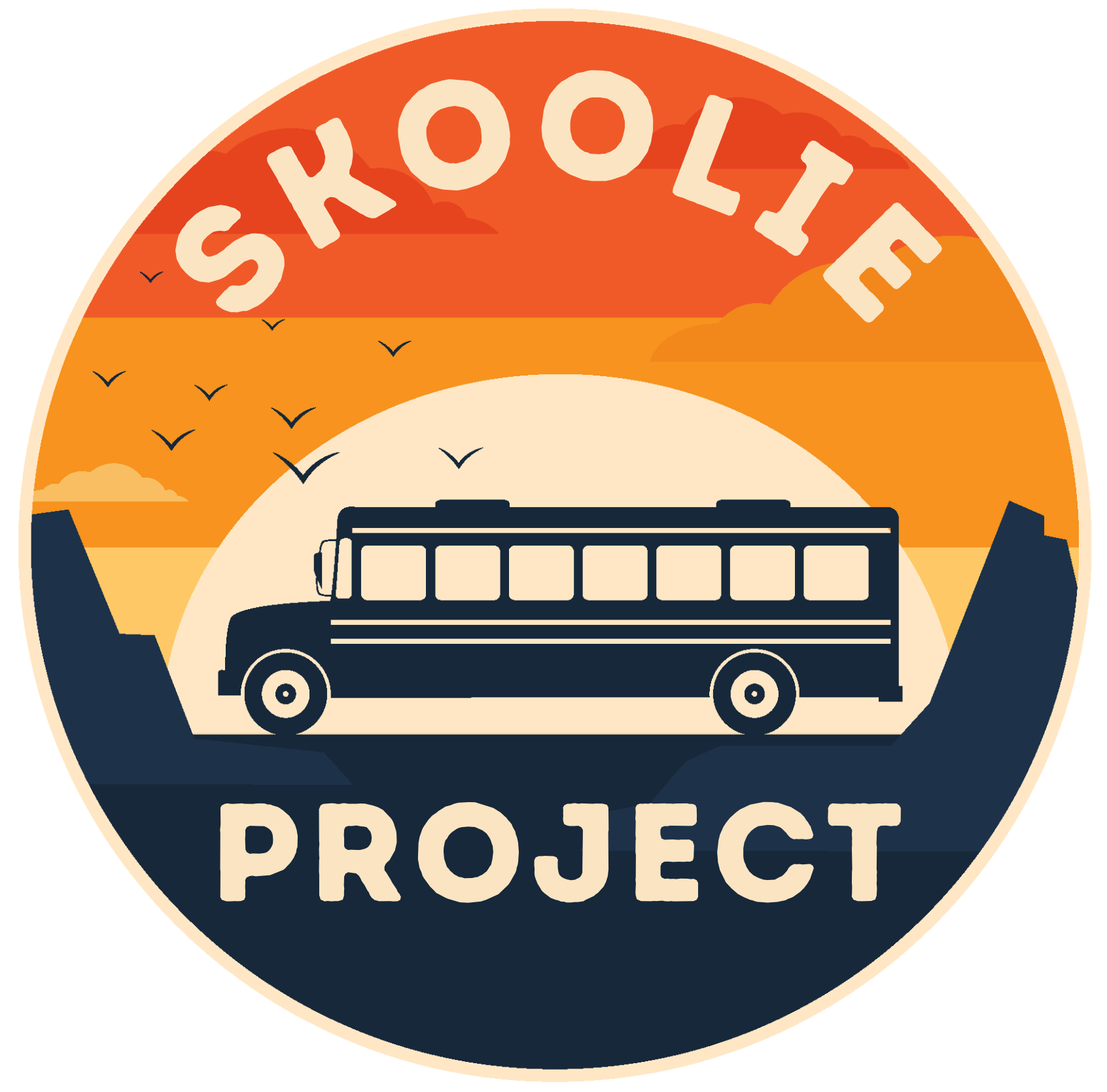

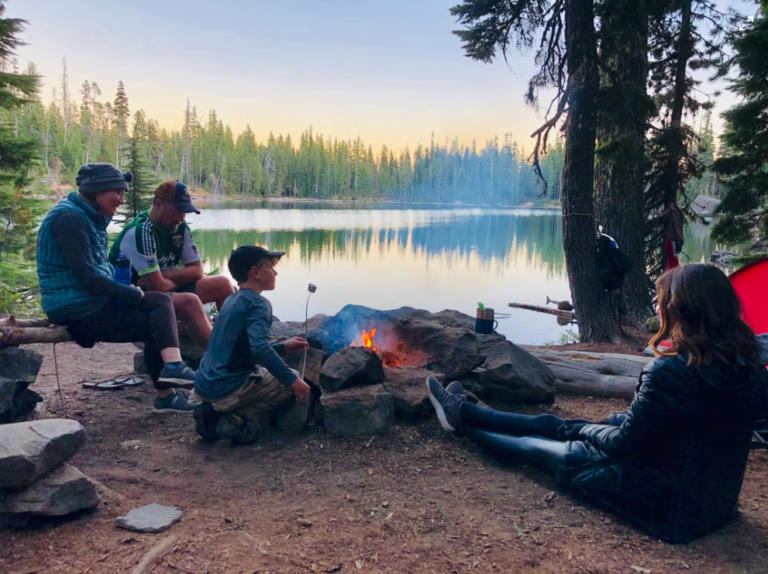
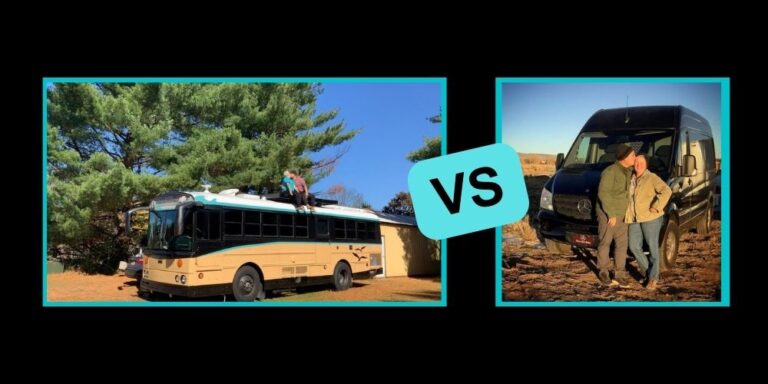
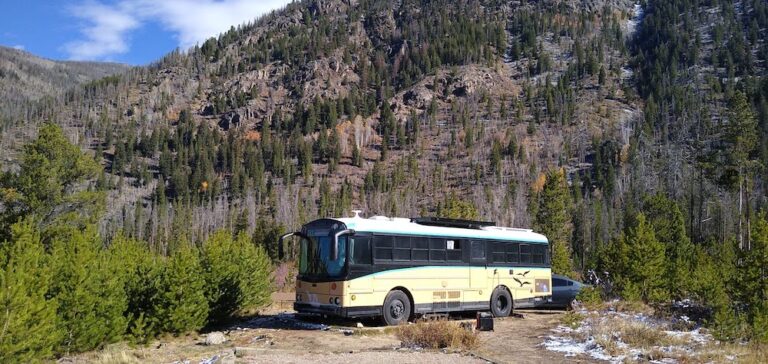

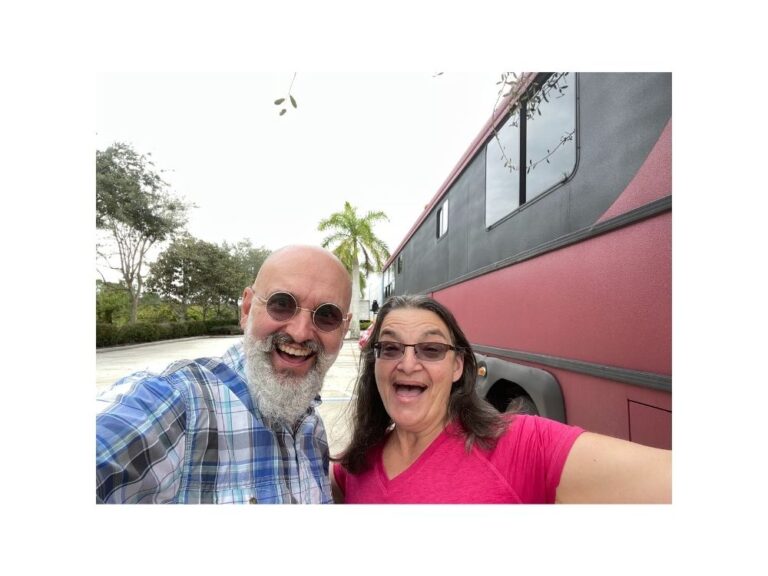
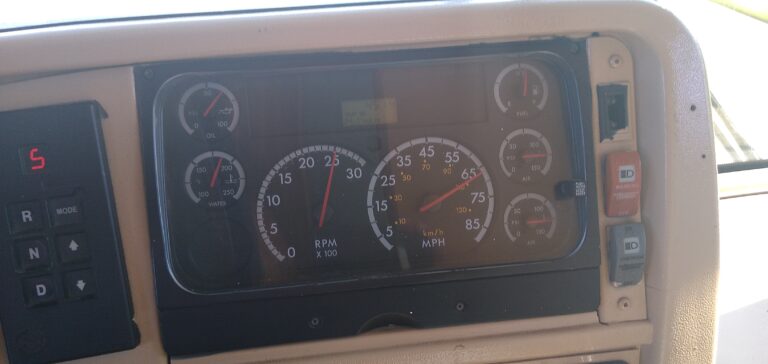
Black water and grey water tanks are usually made of plastic. They are pretty expensive too. I will be using 55 gallon steel drums for black and grey water holding tanks. These tanks run around $10.00 apiece. They are mounted underneath the bus floor.